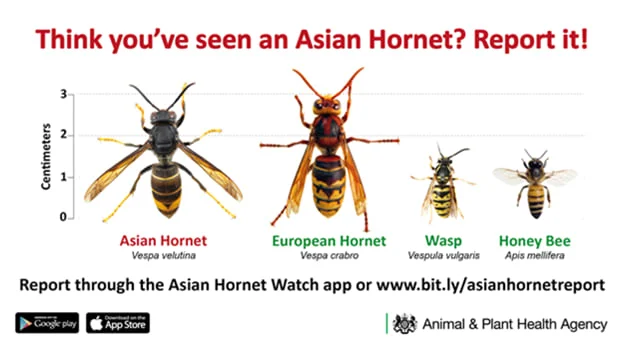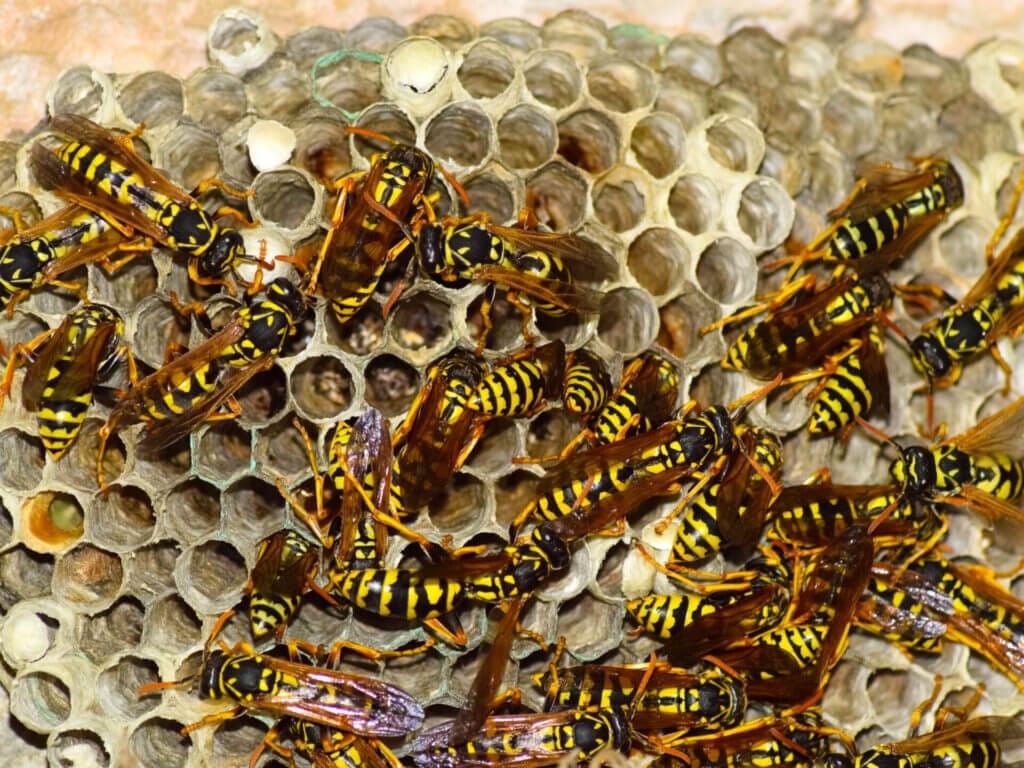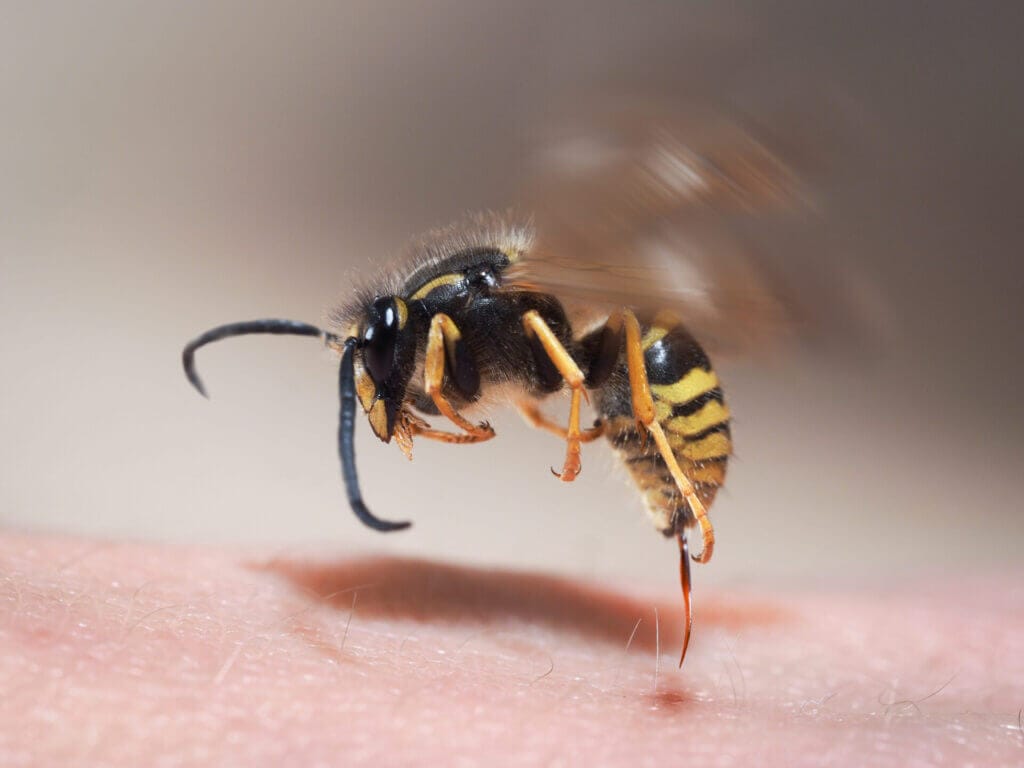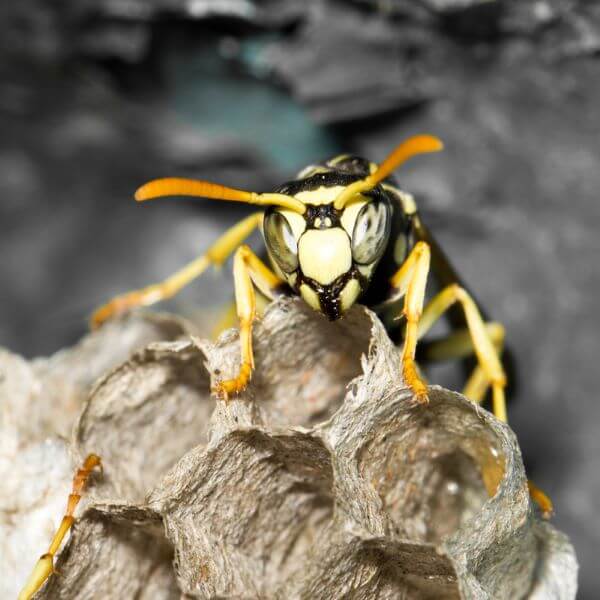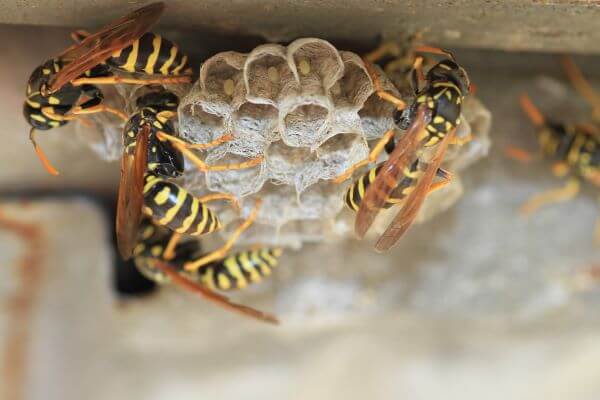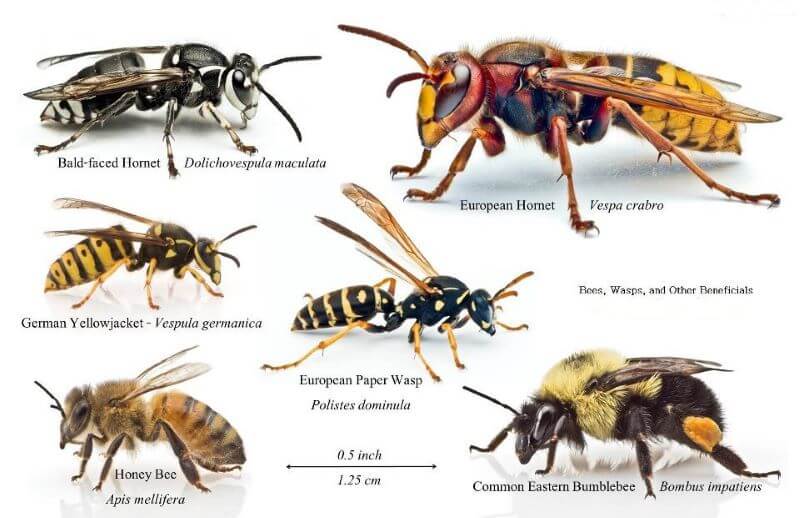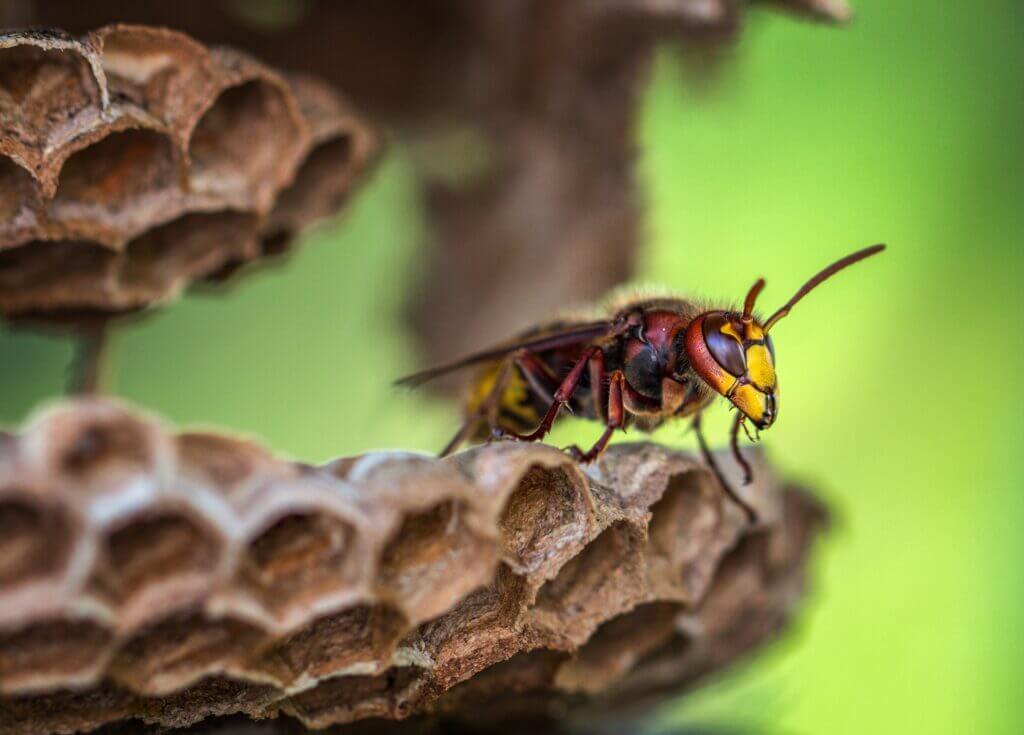Expert Advice on How To Control Wasps Nests in 2023
Wasp Basics and Wasp Nests
There are two main wasp species that cause problems in the UK. The German Wasp, Vespula germanica and the Common Wasp, Vespula vulgaris. German Wasps normally nest in the ground or in bushes, whereas the Common Wasp is more often found within structures created by man, but is also found in the ground and bushes. In recent years, the Median Wasp, Vespula dolicho media has become a problem, usually nesting in bushes, often at about head height and therefore becoming a serious risk to passers by.
Dealing with wasp nests can be somewhat dangerous as they can sting multiple times, not just once, like a bee. Wasps will instinctively attack anyone that ventures too near to their nest, they usually have lookout wasps near the entrance to the nest and these seem to have some kind of communication with wasps that are within the nest. When danger appears, suddenly, so do a number of wasps.
From May to November, wasps can be troublesome, particularly if you have a wasp nest somewhere near your property.
PLEASE NOTE: Wasps can be dangerous if you are allergic to the stings, anaphylactic shock from a sting can result in serious and potentially fatal swelling. ALWAYS WEAR PROTECTIVE CLOTHING WHEN DEALING WITH WASP NESTS
Here is some information and advice about wasps and how to control and eradicate wasp nests.
In this article
Destroying a Wasp Nest in a Bush or Shrub
Destroying a Wasp Nest in the Ground
Destroying a Wasp Nest in the Eaves
Destroying a Wasp Nest in a Roof Void
Destroying a Wasp Nest at a High Level
Clearly, getting rid of a nest can provide fairly instant relief from wasp problems, although, expect to continue to see wasps in the nest areas for the rest of the day after treatment as many will be out foraging and may not return for some time. If you remove a wasps nest, the foraging wasps will return and may hang around the nest area for a couple of days, which is why it is best to leave a treated nest in situ so that returning wasps will enter the nest and be killed with the remaining chemical.
Wasps can become confused as to where their nest is located when nest in man made structures, usually new young wasps, on their early trips out of the nest. These young wasps can have difficulty locating the correct route back. Please check that the wasps are actually flying directly into the entry point and not milling around outside, if they are doing the latter, it is likely that the actual nest is in a neighbouring property that looks like your house ie: same colour, same elevation style. Visually check similar houses either side of yours, as treating at your house will not clear a nest that is next door. The “lost wasp” syndrome often fools even the best pest controller. If you live in a semi detached house, check the house next door but one, as this house is probably very similar to yours.
Destroying a Wasp Nest in a Bush or Shrub
Firstly, make sure you have some protective clothing, particularly a mask if you are using dust/powder insecticide.
Stand about 15 feet from the nest and watch to determine if the wasps have an in and an out flight path, it is usually best to stand in the out flypath rather than the in path.
First choice is always to use an insecticidal powder or dust to destroy a nest. We suggest RENTOKIL WASP KILLER POWDER 300gm
Try to cover the nest with powder either direct from the pack, or preferably using the Polminor Duster Bellows.
The Digrain Wasp and Hornet Nest Killer Aerosol (professional use) could be used if you were trained as a professional, with this product you could treat the nest from around 6-8 feet away.
Destroying a Wasp Nest in the Ground
Wasps very often nest in the ground and these nests are very easy to deal with.
No equipment is required. Just puff the wasp killer insecticidal dust from Rentokil. RENTOKIL WASP NEST KILLER DUST
Destroying a Wasp Nest in the Eaves
House eaves are probably the most common place for wasps to nest and cause problems. When wasps are seen coming to and from the eaves of your home this would normally indicate that there is a nest there.
Eaves nests can often be easily treated from within the roof. Often, the wasp nest will be down in the eaves at the edge of open loft area. If possible, do not turn on a loft light. Use a torch to locate the nest but turn the torch away from the nest as soon as you see it, otherwise wasps will come toward the light.
The Rentokil Wasp Killer Powder will probably be all you need providing the nest is not too far down the eaves ie: not more the 500mm down. If it is further than that or if you want to have a better application method, purchase a POLMINOR BELLOWS DUSTER.
If the nest is not accessible from within the roof, then you have a couple of options. Use a ladder and the bellows or Pump Duster and dust directly into the wasp nest entry point using Rentokil Wasp Nest Killer Powder, or Ficam D, alternatively, for safety, use a high reach dust applicator such as the Kerminator (2 mtr reach) or the DR5 Compression Duster (reach depends on number of 1.5 metre extension lances used). Our new product for 202o is the PCD wasp powder duster, a smaller version of the DR5, you can use all the accessories you can add to the DR5 as well, so a cheaper less bulky alternative.
If you are going to deal with a nest from a ladder, then we strongly recommend the use of full protective clothing ie: Beekeepers Suit.
If the nest is not accessible from within the roof, then you have a couple of options. Use a ladder and the bellows or Pump Duster and dust directly into the wasp nest entry point using Rentokil Wasp Nest Killer Powder, or Ficam D, alternatively, for safety, use a high reach dust applicator such as the Kerminator (2mtr reach) the DR5 Compression Duster (reach depends on number of 1.5 metre extension lances used).
Destroying a Wasp Nest in a Roof Void 
Wasps have a habit of finding access points under roof tiles and roof flashing, particularly around dormer windows, they often nest at the point where the dormer roof meets the main roof. The nest can sometimes be located within the main roof if access is possible.
Openly accessible nests in a roof void present a difficult scenario for the untrained person, unless you have a full protective WASP PROOF SUIT.
This is a high risk wasp nest that although easily accessible, is a whole pack of what will be angry wasps, ready and able to exit the nest quickly and attack. A good quality fly and wasp killer aerosol is useful for added protection and a quick spray of the nest before your main attack will knock down the workers that will almost certainly be on the outside of the nest adding and extending layers.
Wasp killer powder/dust is always our preference in dealing with nearly all wasp nests but using a puffer duster on a hanging nest in a roof void is risky. If possible, use a Gilmour duster or Polminor Bellow Duster and coat as much of the outside of the nest as possible with dust, failing that, use Rentokil Wasp Nest Killer Foam Aerosol and cover as much of the nest as you can in wasp killer foam before promptly vacating the roof.
When treating wasp nests in the eaves of a roof, you can safely break into the nest with the duster lance and get wasp killer powder inside the nest, but DO NOT try that with a hanging nest unless you are fairly sure it won’t fall to the loft floor. If the wasp nest falls and you don’t have full protective clothing on, vacate the roof and call a professional.
If nest is hanging from the rafters and not more than 4 metres off the loft floor, use a Lodi Power Fogger set off directly under the nest. We would have suggested an Agropharm Midi Fumer in preference to the Power Fogger but you are lighting something in a high fire risk area so, although the smoke generator would probably be better, it is much more dangerous in view of the fact the wasps may drive you out of the roof before you can check that the smoke generator has finished burning. The Power Fogger has no fire risk but if you have a heating boiler in the roof, you need to extinguish any flame prior to using the Power Fogger so then you are back to smoke!
Destroying a Wasp Nest at a High Level
Sometimes, although a nest may be in a roof void, you have no access to get to it, you then need to attack from outside the roof void.
The best piece of equipment for this job is the new Kerminator 2 mtr reach. Use You can use the Kerminator into a direct nest or up to 2 mtrs away with added extension of 1 mtr that is available as an add on.
We also would recommend our new product launched in Summer 2020, a DR5 comparison product PCD Wasp Duster 3l. This can have the DR5 extension lances attached to give you a maximum reach of over 6 meters.
Destroying a Wasp Nest in an Air Brick
Wasps very often make their nests behind air bricks and these are the very easiest for an amateur to destroy.
Although the wasps are entering the air brick, the nest may be up to 6 feet away under a building or it may be directly behind or to the side of the air brick, ie: in a cavity wall.
Use a powder/dust to kill these wasps. make several attempts to eradicate a nest behind an air brick. Usually, 3 daily puffs of Rentokil Wasp Nest Killer Powder will do the trick. Apply over the whole air brick as the wasps will use other holes in the brick if you don’t treat all the vent holes. Do it late at night if you are too scared to approach the wasps during the day, however, treatment during the day will be more likely to work rapidly. Even at night, there will be some guard wasps at the entrance to the wasp nest. Our new mini powder duster is ideal for applying the wasp powder for this situation.
We are the Wasp Nest Removal experts
We have been experts in the removal of wasp nests for two generations. The products we sell will certainly help you to eliminate this nuisance, or visit our find a pest controller page for a professional who can visit your home or workplace. If you need any extra advice on wasp nest removal, then do give us a buzz!
All Wasp Control Guides
Frequently asked questions on Wasps in the UK
The two main wasp species in the UK are the German Wasp (Vespula germanica) and the Common Wasp (Vespula vulgaris). In recent years, the Median Wasp (Vespula dolicho media) has also become a problem in the UK.
Yes, wasps can sting multiple times. Unlike bees, which can only sting once and then die, wasps can sting multiple times and will continue to do so if they feel threatened or provoked.
Removing a wasp nest can be dangerous as wasps will instinctively attack anyone who comes near their nest. It is recommended to wear protective clothing, such as a mask and long sleeves, when removing a wasp nest. If you are allergic to wasp stings, it is best to hire a professional to remove the nest.
If you see wasps flying in and out of a specific entrance, it is likely that the nest is located in that area. If the wasps are milling around outside and do not seem to be going in and out of a specific entrance, it is possible that the nest is located in a neighboring property that looks similar to yours. In this case, you should visually check similar houses on either side of yours to determine the location of the nest.
To destroy a wasp nest in a bush or shrub, it is recommended to use an insecticidal powder or dust, such as RENTOKIL WASP KILLER POWDER. You can apply the powder directly from the pack or use a duster bellows to cover the nest. If you are trained as a professional, you can also use an insecticidal aerosol spray, such as Digrain Wasp and Hornet Nest Killer Aerosol, to treat the nest from a safe distance of 6-8 feet away.
To destroy a wasp nest in the ground, you can use an insecticidal dust, such as RENTOKIL WASP NEST KILLER DUST. Simply puff the dust into the entrance of the nest.
To destroy a wasp nest in the eaves of a house, you can use an insecticidal powder or dust, such as RENTOKIL WASP KILLER POWDER. You can apply the powder directly from the pack or use a duster bellows to cover the nest. If the nest is out of reach, you can also use an insecticidal aerosol spray, such as Digrain Wasp and Hornet Nest Killer Aerosol, to treat the nest from a safe distance.
To destroy a wasp nest in a roof void, it is recommended to hire a professional pest control company. The technician will be able to safely access the nest and treat it with an appropriate insecticide.
To destroy a wasp nest at a high level, it is recommended to hire a professional pest control company. The technician will have the necessary equipment and training to safely access and treat the nest.
To destroy a wasp nest in an air brick, you can use an insecticidal powder or dust, such as RENTOKIL WASP KILLER POWDER. You can apply the powder directly into the entrance of the nest using a long-handled applicator or a duster bellows. If the nest is out of reach, you can also use an insecticidal aerosol spray, such as Digrain Wasp and Hornet Nest Killer Aerosol, to treat the nest from a safe distance.
If you are allergic to wasp stings, it is important to carry an epinephrine injector (epi-pen) with you at all times and to seek immediate medical attention if you are stung. It is also recommended to avoid areas where wasp nests are present and to wear protective clothing, such as long sleeves and a hat, when outdoors. If you need to remove a wasp nest, it is best to hire a professional to do it for you.
Yes, you can use an insecticidal spray to destroy a wasp nest. However, it is important to follow the instructions on the label and to use the spray in a well-ventilated area to avoid inhaling the chemicals. It is also recommended to wear protective clothing, such as a mask and long sleeves, when using the spray.
Yes, it is recommended to wear protective clothing, such as a mask and long sleeves, when destroying a wasp nest. This will help to protect you from being stung by the wasps and inhaling any chemicals that you may be using to treat the nest.
It may take several hours or days for a wasp nest to be fully destroyed, depending on the size of the nest and the type of treatment being used. After the initial treatment, it is common to see wasps in the area for the rest of the day as many will be out foraging and may not return to the nest for some time.
There are several steps you can take to prevent wasp nests from forming on your property:
- Keep garbage and food waste securely covered to avoid attracting wasps.
- Repair any holes or cracks in the exterior of your home to prevent wasps from entering.
- Use screens on windows and doors to keep wasps out.
- Use wasp traps to capture and kill was
- Use wasp repellents, such as insecticidal sprays or natural options like peppermint oil or citrus scents, to deter wasps from entering your property.
- Avoid wearing perfumes or using scented products, as these can attract wasps.
- Keep a safe distance from wasp nests and avoid disturbing them.
If you are allergic to wasp stings or if the nest is located in a hard-to-reach area, it is recommended to hire a professional pest control company to remove the nest. If the nest is accessible and you feel comfortable doing it yourself, you can use an insecticidal powder or dust to destroy the nest. However, it is important to follow the instructions on the product label and to wear protective clothing to avoid being stung.
While there are many homemade remedies that are said to be effective at destroying wasp nests, it is generally safer and more effective to use a commercial insecticide that is specifically designed for this purpose. Homemade remedies may not be as effective and could also be dangerous to use.
An active wasp nest will have a steady stream of wasps coming in and out of it, and the nest will likely be larger in size. An abandoned nest will have no visible activity and may appear smaller and dry.
If you find a wasp nest in a hard-to-reach place, such as a high ceiling or a wall void, it is recommended to hire a professional pest control company to remove it. The technician will have the necessary equipment and training to safely access and treat the nest.
It is generally okay to destroy a wasp nest if it is not causing any problems and you feel comfortable doing so. However, it is important to follow proper safety precautions and to use an appropriate insecticide to effectively destroy the nest. If you are unsure about how to safely remove a wasp nest, it is best to hire a professional pest control company to do it for you.


